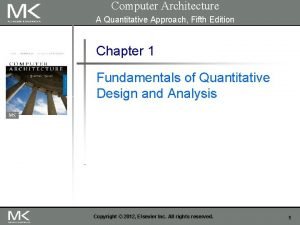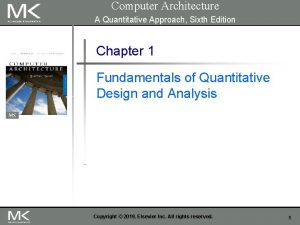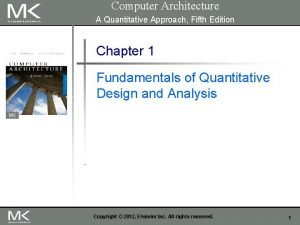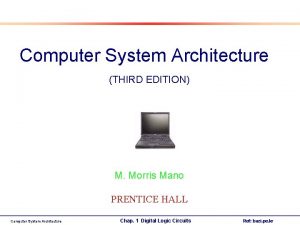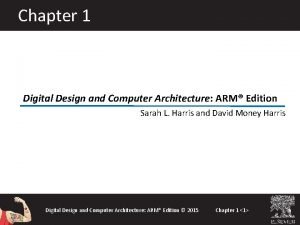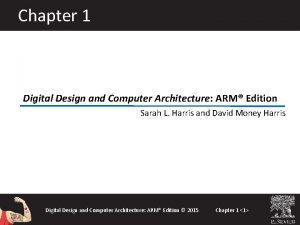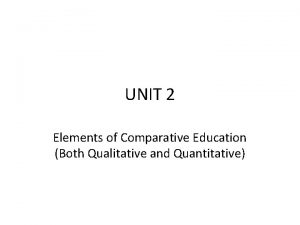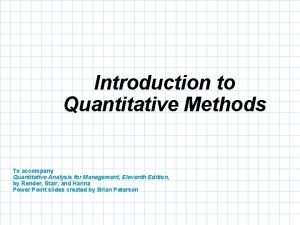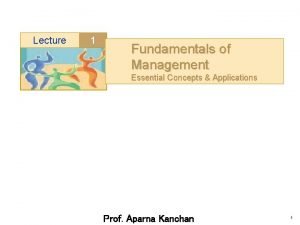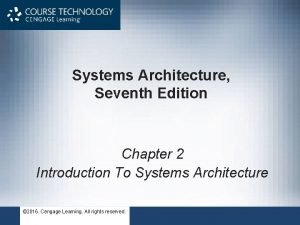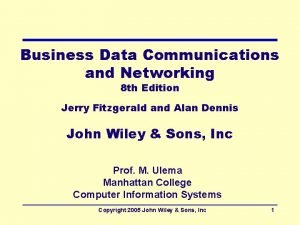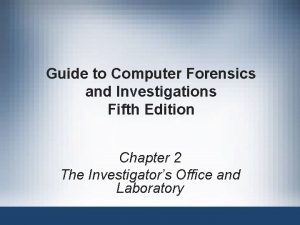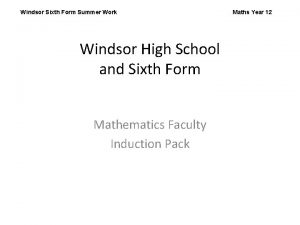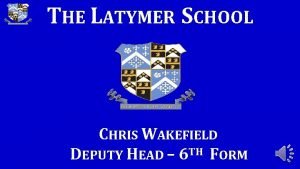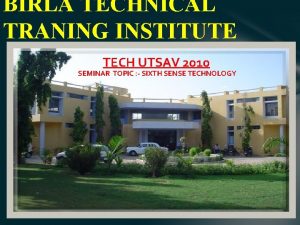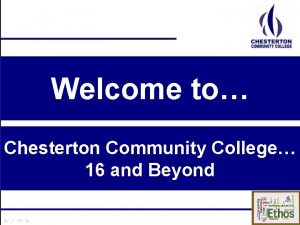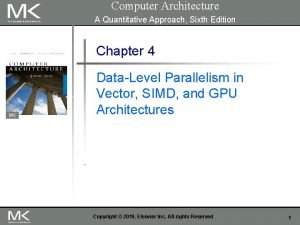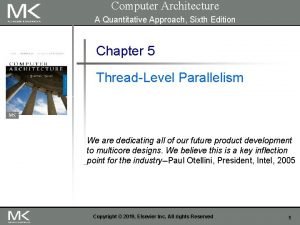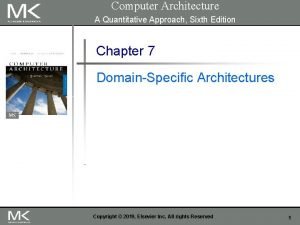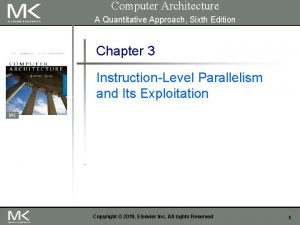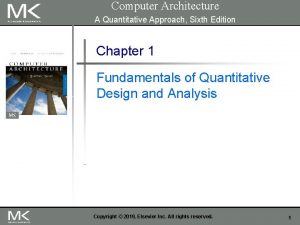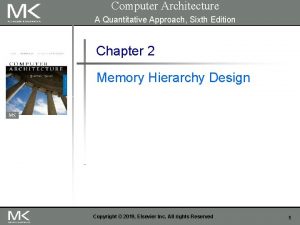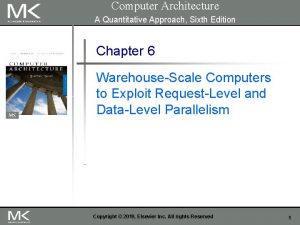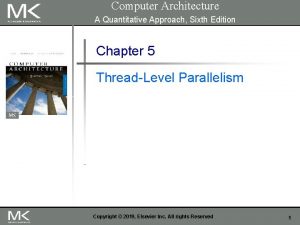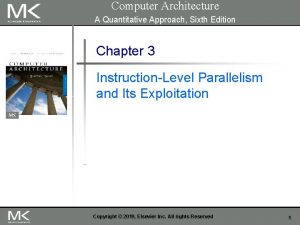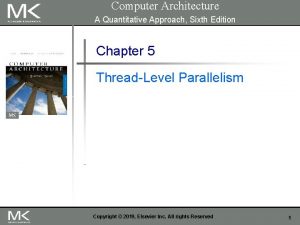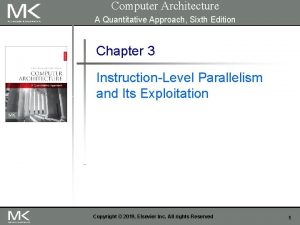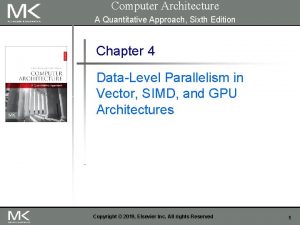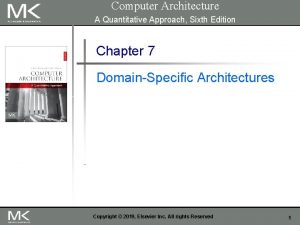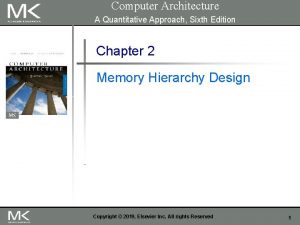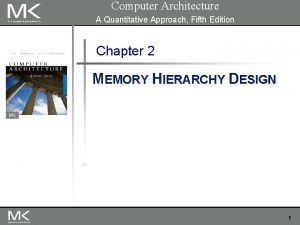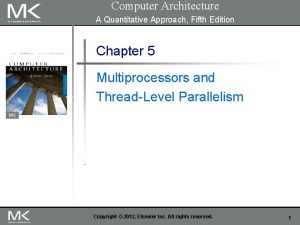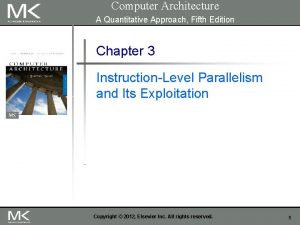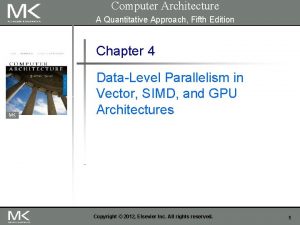Computer Architecture A Quantitative Approach Sixth Edition Chapter























![n Stacked DRAMs in same package as processor [shorter distance/latency, more connections/bandwidth] n High n Stacked DRAMs in same package as processor [shorter distance/latency, more connections/bandwidth] n High](https://slidetodoc.com/presentation_image_h/03a3094b8c53cb67920dfab62240402e/image-24.jpg)



















































- Slides: 75

Computer Architecture A Quantitative Approach, Sixth Edition Chapter 2 Memory Hierarchy Design Copyright © 2019, Elsevier Inc. All rights Reserved 1

n n n Programmers want unlimited amounts of memory with low latency Fast memory technology is more expensive per bit than slower memory Solution: organize memory system into a hierarchy n n n Introduction Entire addressable memory space available in largest, slowest memory Incrementally smaller and faster memories, each containing a subset of the memory below it, proceed in steps up toward the processor Temporal and spatial locality insures that nearly all references can be found in smaller memories n Gives the allusion of a large, fast memory being presented to the processor Copyright © 2019, Elsevier Inc. All rights Reserved 2

Copyright © 2019, Elsevier Inc. All rights Reserved Introduction Memory Hierarchy 3

Figure 2. 1 The levels in a typical memory hierarchy in a personal mobile device (PMD), such as a cell phone or tablet (A), in a laptop or desktop computer (B), and in a server (C). As we move farther away from the processor, the memory in the level below becomes slower and larger. Note that the time units change by a factor of 109 from picoseconds to milliseconds in the case of magnetic disks and that the size units change by a factor of 10 10 from thousands of bytes to tens of terabytes. If we were to add warehouse-sized computers, as opposed to just servers, the capacity scale would increase by three to six orders of magnitude. Solid-state drives (SSDs) composed of Flash are used exclusively in PMDs, and heavily in both laptops and desktops. In many desktops, the primary storage system is SSD, and expansion disks are primarily hard disk drives (HDDs). Likewise, many servers mix SSDs and HDDs. 4

Copyright © 2019, Elsevier Inc. All rights Reserved Introduction Memory Performance Gap 5

Figure 2. 2 Starting with 1980 performance as a baseline, the gap in performance, measured as the difference in the time between processor memory requests (for a single processor or core) and the latency of a DRAM access, is plotted over time. In mid-2017, AMD, Intel and Nvidia all announced chip sets using versions of HBM technology. Note that the vertical axis must be on a logarithmic scale to record the size of the processor-DRAM performance gap. The memory baseline is 64 Ki. B DRAM in 1980, with a 1. 07 per year performance improvement in latency (see Figure 2. 4 on page 88). The processor line assumes a 1. 25 improvement per year until 1986, a 1. 52 improvement until 2000, a 1. 20 improvement between 2000 and 2005, and only small improvements in processor performance (on a per-core basis) between 2005 and 2015. As you can see, until 2010 memory access times in DRAM improved slowly but consistently; since 2010 the improvement in access time has reduced, as compared with the earlier periods, although there have been continued improvements in bandwidth. See Figure 1. 1 in Chapter 1 for more information. 6

n Memory hierarchy design becomes more crucial with recent multi-core processors: n Introduction Memory Hierarchy Design Aggregate peak bandwidth grows with # cores: n n Intel Core i 7 can generate two references per core per clock Four cores and 3. 2 GHz clock n 25. 6 billion 64 -bit data references/second + n 12. 8 billion 128 -bit instruction references/second n = 409. 6 GB/s! DRAM bandwidth is only 8% of this (34. 1 GB/s) Requires: n n n Multi-port, pipelined caches Two levels of cache per core Shared third-level cache on chip Copyright © 2019, Elsevier Inc. All rights Reserved 7

n High-end microprocessors have >10 MB on-chip cache n Introduction Performance and Power Consumes large amount of area and power budget Copyright © 2019, Elsevier Inc. All rights Reserved 8

n When a word is not found in the cache, a miss occurs: n n n Fetch word from lower level in hierarchy, requiring a higher latency reference Lower level may be another cache or the main memory Also fetch the other words contained within the block n n Introduction Memory Hierarchy Basics Takes advantage of spatial locality Place block into cache in any location within its set, determined by address n block address MOD number of sets in cache Copyright © 2019, Elsevier Inc. All rights Reserved 9

Figure B. 2 This example cache has eight block frames and memory has 32 blocks. The three options for caches are shown left to right. In fully associative, block 12 from the lower level can go into any of the eight block frames of the cache. With direct mapped, block 12 can only be placed into block frame 4 (12 modulo 8). Set associative, which has some of both features, allows the block to be placed anywhere in set 0 (12 modulo 4). With two blocks per set, this means block 12 can be placed either in block 0 or in block 1 of the cache. Real caches contain thousands of block frames, and real memories contain millions of blocks. The set associative organization has four sets with two blocks per set, called two-way set associative. Assume that there is nothing in the cache and that the block address in question identifies lower-level block 12. 10

Introduction Memory Hierarchy Basics n n sets => n-way set associative [unclear what this line means] n n n Direct-mapped cache => one block per set Fully associative => one set Writing to cache: two strategies n Write-through n n Write-back n n Immediately update lower levels of hierarchy Only update lower levels of hierarchy when an updated block is replaced Both strategies use write buffer to make writes asynchronous Copyright © 2019, Elsevier Inc. All rights Reserved 11

Introduction Memory Hierarchy Basics n Miss rate n n Fraction of cache access that result in a miss Causes of misses n Compulsory n n First reference to a block Capacity n Blocks discarded and later retrieved. Do they mean misses that even a fully associative cache could not avoid? If so, how to determine for individual reference? n Conflict n Program makes repeated references to multiple addresses from different blocks that map to the same location in the cache “The 3 C’s model is conceptual; although its insights usually hold, it is not a definitive model for explaining cache behavior of individual references” p. 82. Copyright © 2019, Elsevier Inc. All rights Reserved 12

n Introduction Memory Hierarchy Basics Speculative and multithreaded processors may execute other instructions during a miss n Reduces performance impact of misses Copyright © 2019, Elsevier Inc. All rights Reserved 13

n Six basic cache optimizations: n Larger block size n n Reduces overall memory access time Giving priority to read misses over writes n n Reduces conflict misses Increases hit time, increases power consumption Higher number of cache levels n n Increases hit time, increases power consumption Higher associativity n n Reduces compulsory misses Increases capacity and conflict misses, increases miss penalty Larger total cache capacity to reduce miss rate n n Introduction Memory Hierarchy Basics Reduces miss penalty Avoiding address translation in cache indexing n Reduces hit time Copyright © 2019, Elsevier Inc. All rights Reserved 14

n Performance metrics n n n Latency is concern of cache Bandwidth is concern of multiprocessors and I/O Access time n n Cycle time n n n Time between read request and when desired word arrives Minimum time between unrelated requests to memory Memory Technology and Optimizations SRAM memory has low latency, use for cache Organize DRAM chips into many banks for high bandwidth, use for main memory Copyright © 2019, Elsevier Inc. All rights Reserved 15

n SRAM n n n Requires low power to retain bit Requires 6 transistors/bit DRAM n n Must be re-written after being read Must also be periodically refreshed n n Memory Technology and Optimizations Memory Technology Every ~ 8 ms (roughly 5% of time) Each row can be refreshed simultaneously One transistor/bit Address lines are multiplexed: n n Upper half of address: row access strobe (RAS) Lower half of address: column access strobe (CAS) Copyright © 2019, Elsevier Inc. All rights Reserved 16

Copyright © 2019, Elsevier Inc. All rights Reserved Memory Technology and Optimizations Internal Organization of DRAM 17

n Amdahl: n n n Memory capacity should grow linearly with processor speed Unfortunately, memory capacity and speed has not kept pace with processors Some optimizations: n n Multiple accesses to same row Synchronous DRAM n n n Added clock to DRAM interface Burst mode with critical word first Memory Technology and Optimizations Memory Technology Wider interfaces Double data rate (DDR) Multiple banks on each DRAM device Copyright © 2019, Elsevier Inc. All rights Reserved 18

Copyright © 2019, Elsevier Inc. All rights Reserved Memory Technology and Optimizations Memory Optimizations 19

Copyright © 2019, Elsevier Inc. All rights Reserved Memory Technology and Optimizations Memory Optimizations 20

n DDR: n DDR 2 n n 1. 5 V 800 MHz DDR 4 n n n Lower power (2. 5 V -> 1. 8 V) Higher clock rates (266 MHz, 333 MHz, 400 MHz) DDR 3 n n [transfers data on both the rising and falling edges of the clock signal] Memory Technology and Optimizations Memory Optimizations 1 -1. 2 V 1333 MHz GDDR 5 is graphics memory based on DDR 3 Copyright © 2019, Elsevier Inc. All rights Reserved 21

n Reducing power in SDRAMs: n n n Lower voltage Low power mode (ignores clock, continues to refresh) Graphics memory: n Achieve 2 -5 X bandwidth per DRAM vs. DDR 3 n n Memory Technology and Optimizations Memory Optimizations Wider interfaces (32 vs. 16 bit) Higher clock rate n Possible because they are attached via soldering instead of socketed DIMM modules … Soldering led to HBM (successor to GDDR 5? ) Copyright © 2019, Elsevier Inc. All rights Reserved 22

Copyright © 2019, Elsevier Inc. All rights Reserved Memory Technology and Optimizations Memory Power Consumption 23
![n Stacked DRAMs in same package as processor shorter distancelatency more connectionsbandwidth n High n Stacked DRAMs in same package as processor [shorter distance/latency, more connections/bandwidth] n High](https://slidetodoc.com/presentation_image_h/03a3094b8c53cb67920dfab62240402e/image-24.jpg)
n Stacked DRAMs in same package as processor [shorter distance/latency, more connections/bandwidth] n High Bandwidth Memory (HBM) Copyright © 2019, Elsevier Inc. All rights Reserved Memory Technology and Optimizations Stacked/Embedded DRAMs 24

n Type of EEPROM [Electrically Erasable Programmable Read-Only Memory and is a type of non-volatile memory] n n Types: NAND (denser) and NOR (faster) NAND Flash: n n n Reads are sequential, reads entire page (. 5 to 4 Ki. B) 25 us for first byte, 40 Mi. B/s for subsequent bytes SDRAM: 40 ns for first byte, 4. 8 GB/s for subsequent bytes 2 Ki. B transfer: 75 u. S vs 500 ns for SDRAM, 150 X slower 300 to 500 X faster than magnetic disk Copyright © 2019, Elsevier Inc. All rights Reserved Memory Technology and Optimizations Flash Memory 25

n n n Must be erased (in blocks) before being overwritten Nonvolatile, can use as little as zero power Limited number of write cycles (~100, 000) $2/Gi. B, compared to $20 -40/Gi. B for SDRAM and $0. 09 Gi. B for magnetic disk [Gi. B=232 Bytes. GB=109 Bytes] Memory Technology and Optimizations NAND Flash Memory Phase-Change/Memrister Memory n Possibly 10 X improvement in write performance and 2 X improvement in read performance Copyright © 2019, Elsevier Inc. All rights Reserved 26

n n Memory is susceptible to cosmic rays Soft errors: dynamic errors n n Detected and fixed by error correcting codes (ECC) Hard errors: permanent errors n Use spare rows to replace defective rows Memory Technology and Optimizations Memory Dependability Chipkill: a RAID-like error recovery technique n RAID- Redundant Array of Independent Disks Copyright © 2019, Elsevier Inc. All rights Reserved 27

n Reduce hit time n n n Increase bandwidth n n Critical word first, merging write buffers Reduce miss rate n n Pipelined caches, multibanked caches, non-blocking caches Reduce miss penalty n n Small and simple first-level caches Way prediction Advanced Optimizations Compiler optimizations Reduce miss penalty or miss rate via parallelization n Hardware or compiler prefetching Copyright © 2019, Elsevier Inc. All rights Reserved 28

Advanced Optimizations L 1 Size and Associativity Access time vs. size and associativity Copyright © 2019, Elsevier Inc. All rights Reserved 29

Advanced Optimizations L 1 Size and Associativity Energy per read vs. size and associativity Copyright © 2019, Elsevier Inc. All rights Reserved 30

n To improve hit time, predict the way to pre-set mux (using extra bit(s) ) n n Mis-prediction gives longer hit time Prediction accuracy n n n Advanced Optimizations Way Prediction > 90% for two-way > 80% for four-way I-cache has better accuracy than D-cache First used on MIPS R 10000 in mid-90 s Used on ARM Cortex-A 8 Extend to predict block as well n n “Way selection” Increases mis-prediction penalty Example: 4 -way set-associative. Predicts which of the 4 blocks in a set to read next Copyright © 2019, Elsevier Inc. All rights Reserved 31

n Pipeline cache access to improve bandwidth n Examples: n n n Pentium: 1 cycle Pentium Pro – Pentium III: 2 cycles Pentium 4 – Core i 7: 4 cycles Advanced Optimizations Pipelined Caches Increases branch mis-prediction penalty Makes it easier to increase associativity Copyright © 2019, Elsevier Inc. All rights Reserved 32

n Organize cache as independent banks to support simultaneous access n n n ARM Cortex-A 8 supports 1 -4 banks for L 2 Intel i 7 supports 4 banks for L 1 and 8 banks for L 2 Advanced Optimizations Multibanked Caches Interleave banks according to block address Copyright © 2019, Elsevier Inc. All rights Reserved 33

n Allow hits before previous misses complete n n “Hit under miss” “Hit under multiple miss” L 2 must support this In general, processors can hide L 1 miss penalty but not L 2 miss penalty Copyright © 2019, Elsevier Inc. All rights Reserved Advanced Optimizations Nonblocking Caches 34

Figure 2. 11 The effectiveness of a nonblocking cache is evaluated by allowing 1, 2, or 64 hits under a cache miss with 9 SPECINT (on the left) and 9 SPECFP (on the right) benchmarks. The data memory system modeled after the Intel i 7 consists of a 32 Ki. B L 1 cache with a four-cycle access latency. The L 2 cache (shared with instructions) is 256 Ki. B with a 10 -clock cycle access latency. The L 3 is 2 Mi. B and a 36 -cycle access latency. All the caches are eight-way set associative and have a 64 -byte block size. Allowing one hit under miss reduces the miss penalty by 9% for the integer benchmarks and 12. 5% for the floating point. Allowing a second hit improves these results to 10% and 16%, and allowing 64 results in little additional improvement. 35

n Critical word first n n n Request missed word from memory first Send it to the processor as soon as it arrives Early restart n n Advanced Optimizations Critical Word First, Early Restart Request words in normal order Send missed work to the processor as soon as it arrives Beneficial if block are large n Effectiveness of these strategies depends on block size and likelihood of another access to the portion of the block that has not yet been fetched Copyright © 2019, Elsevier Inc. All rights Reserved 36

n n n When storing to a block that is already pending in the write buffer, update write buffer Reduces stalls due to full write buffer Do not apply to I/O addresses Advanced Optimizations Merging Write Buffer No write buffering Write buffering Copyright © 2019, Elsevier Inc. All rights Reserved 37

Figure 2. 12 In this illustration of write merging, the write buffer on top does not use write merging while the write buffer on the bottom does. The four writes are merged into a single buffer entry with write merging; without it, the buffer is full even though three-fourths of each entry is wasted. The buffer has four entries, and each entry holds four 64 -bit words. The address for each entry is on the left, with a valid bit (V) indicating whether the next sequential 8 bytes in this entry are occupied. (Without write merging, the words to the right in the upper part of the figure would be used only for instructions that wrote multiple words at the same time. ) 38

n Loop Interchange n Swap nested loops to access memory in sequential order Example: if a matrix is stored in row order and loop accesses it in column order switch to row order n Advanced Optimizations Compiler Optimizations Blocking n n Instead of accessing entire rows or columns, subdivide matrices into blocks Requires more memory accesses but improves locality of accesses If cache can store B 2 memory words but not an entire matrix… Copyright © 2019, Elsevier Inc. All rights Reserved 39

Blocking for (i = 0; i < N; i = i + 1) for (j = 0; j < N; j = j + 1) { r = 0; for (k = 0; k < N; k = k + 1) r = r + y[i][k]*z[k][j]; x[i][j] = r; }; Copyright © 2019, Elsevier Inc. All rights Reserved 40

Figure 2. 13 A snapshot of the three arrays x, y, and z when N = 6 and i = 1. The age of accesses to the array elements is indicated by shade: white means not yet touched, light means older accesses, and dark means newer accesses. The elements of y and z are read repeatedly to calculate new elements of x. The variables i, j, and k are shown along the rows or columns used to access the arrays. 41

Blocking for (jj = 0; jj < N; jj = jj + B) for (kk = 0; kk < N; kk = kk + B) for (i = 0; i < N; i = i + 1) for (j = jj; j < min(jj + B, N); j = j + 1) { The range r = 0; for (k = kk; k < min(kk + B, N); k = k + 1) r = r + y[i][k]*z[k][j]; x[i][j] = x[i][j] + r; }; Copyright © 2019, Elsevier Inc. All rights Reserved of j (and k) is B 42

Figure 2. 14 The age of accesses to the arrays x, y, and z when B = 3. Note that, in contrast to Figure 2. 13, a smaller number of elements is accessed. 43

n Fetch two blocks on miss (include next sequential block) Advanced Optimizations Hardware Prefetching Pentium 4 Pre-fetching Copyright © 2019, Elsevier Inc. All rights Reserved 44

n n n Insert prefetch instructions before data is needed Non-faulting: prefetch doesn’t cause exceptions for virtual address faults and protection violations Register prefetch n n Loads data into register Cache prefetch n n Advanced Optimizations Compiler Prefetching Loads data into cache Combine with loop unrolling and software pipelining Copyright © 2019, Elsevier Inc. All rights Reserved 45

n 128 Mi. B to 1 Gi. B Smaller blocks require substantial tag storage Larger blocks are potentially inefficient n One approach (L-H): n n n Advanced Optimizations Use HBM to Extend Hierarchy Each SDRAM row is a block index Each row contains set of tags and 29 data segments 29 -set associative Hit requires a CAS Copyright © 2019, Elsevier Inc. All rights Reserved 46

n Another approach (Alloy cache): n n n Mold tag and data together Use direct mapped Advanced Optimizations Use HBM to Extend Hierarchy Both schemes require two DRAM accesses for misses n Two solutions: n n Use map to keep track of blocks Predict likely misses Copyright © 2019, Elsevier Inc. All rights Reserved 47

Copyright © 2019, Elsevier Inc. All rights Reserved Advanced Optimizations Use HBM to Extend Hierarchy 48

Copyright © 2019, Elsevier Inc. All rights Reserved Advanced Optimizations Summary 49

Virtual memory, Section B 4 Initially meant to remove the burden of the programmers from having to deal with physical memory Figure B. 19 The logical program in its contiguous virtual address space is shown on the left. It consists of four pages, A, B, C, and D. The actual location of three of the blocks is in physical main memory and the other is located on the disk. 50

Protection Segue: HP-2012 slides for self-contained presentation n n Virtual memory Virtual machines Copyright © 2012, Elsevier Inc. All rights reserved. 51

The Limits of Physical Addressing “Physical addresses” of memory locations A 0 -A 31 CPU Memory D 0 -D 31 Data All programs share one address space: The physical address space Machine language programs must be aware of the machine organization No way to prevent a program from accessing any machine resource 52

Solution: Add a Layer of Indirection “Physical Addresses” “Virtual Addresses” A 0 -A 31 Virtual Physical Address Translation CPU A 0 -A 31 Memory D 0 -D 31 Data User programs run in an standardized virtual address space Address Translation hardware managed by the operating system (OS) maps virtual address to physical memory Hardware supports “modern” OS features: Protection, Translation, Sharing 53

Three Advantages of Virtual Memory n n n Translation: n Program can be given consistent view of memory, even though physical memory is scrambled n Makes multithreading reasonable (now used a lot!) n Only the most important part of program (“Working Set”) must be in physical memory. n Contiguous structures (like stacks) use only as much physical memory as necessary yet still grow later. Protection: n Different threads (or processes) protected from each other. n Different pages can be given special behavior n (Read Only, Invisible to user programs, etc). n Kernel data protected from User programs n Very important for protection from malicious programs Sharing: n Can map same physical page to multiple users (“Shared memory”) CS 252 -s 06, Lec 04 -cache review 2/20/2021 54 54

Page tables encode virtual address spaces Page Table Physical Memory Space frame A virtual address space is divided into blocks of memory called pages frame virtual address OS manages the page table for each ASID (thread) A A machine usually supports pages of a few sizes (MIPS R 4000): A page table is indexed by a virtual address valid page table entry codes physical memory “frame” address for the page 55

TLB Design Concepts (Translation Look-Aside Buffer) Anecdote TLB preceded caches, since address delays preceded data & instruction delays. Still what is better known: TLBs or caches? 56

MIPS Address Translation: How does it work? “Physical Addresses” “Virtual Addresses” Virtual A 0 -A 31 CPU D 0 -D 31 Data Physical Translation Look-Aside Buffer (TLB) A 0 -A 31 Memory D 0 -D 31 What is the table Translation Look-Aside Buffer (TLB) of A small fully-associative cache of mappings from virtual to physical addresses that it caches? TLB also contains protection bits for virtual address Fast common case: Virtual address is in TLB, process has permission to read/write it. 57

Summary: TLB, Virtual Memory n n n Page tables map virtual address to physical address TLBs are important for fast translation TLB misses are significant in processor performance n n n funny times, as most systems can’t access all of 2 nd level cache without TLB misses! Caches, TLBs, Virtual Memory all understood by examining how they deal with 4 questions: 1) Where can block be placed? 2) How is block found? 3) What block is replaced on miss? 4) How are writes handled? Today VM allows many processes to share single memory without having to swap all processes to disk; today VM protection is more important than memory hierarchy benefits, but computers insecure CS 252 -s 06, Lec 04 -cache review 2/20/2021 58 58

Introduction to Virtual Machines n n VMs developed in late 1960 s n Remained important in mainframe computing over the years n Largely ignored in single user computers of 1980 s and 1990 s Recently regained popularity due to n increasing importance of isolation and security in modern systems, n failures in security and reliability of standard operating systems, n sharing of a single computer among many unrelated users, n and the dramatic increases in raw speed of processors, which makes the overhead of VMs more acceptable CS 252 s 06 Adv. Memory Hierarchy 2/20/2021 59 59

What is a Virtual Machine (VM)? n n n Broadest definition includes all emulation methods that provide a standard software interface, such as the Java VM “(Operating) System Virtual Machines” provide a complete system level environment at binary ISA n Here assume ISAs always match the native hardware ISA n E. g. , IBM VM/370, VMware ESX Server, and Xen Present illusion that VM users have entire computer to themselves, including a copy of OS Single computer runs multiple VMs, and can support a multiple, different OSes n On conventional platform, single OS “owns” all HW resources n With a VM, multiple OSes all share HW resources Underlying HW platform is called the host, and its resources are shared among the guest VMs CS 252 s 06 Adv. Memory Hierarchy 2/20/2021 60 60

Virtual Machine Monitors (VMMs) n n Virtual machine monitor (VMM) or hypervisor is software that supports VMM determines how to map virtual resources to physical resources Physical resource may be time-shared, partitioned, or emulated in software VMM is much smaller than a traditional OS; n isolation portion of a VMM is 10, 000 lines of code CS 252 s 06 Adv. Memory Hierarchy 2/20/2021 61 61

VMM Overhead? n n Depends on the workload User-level processor-bound programs (e. g. , SPEC) have zerovirtualization overhead n Runs at native speeds since OS rarely invoked I/O-intensive workloads OS-intensive execute many system calls and privileged instructions can result in high virtualization overhead n For System VMs, goal of architecture and VMM is to run almost all instructions directly on native hardware If I/O-intensive workload is also I/O-bound (I/O is the bottleneck? ) low processor utilization since waiting for I/O processor virtualization can be hidden low virtualization overhead CS 252 s 06 Adv. Memory Hierarchy 2/20/2021 62 62

Other Uses of VMs n n 1. 2. Focus here on protection 2 Other commercially important uses of VMs Managing Software n VMs provide an abstraction that can run the complete SW stack, even including old OSes like DOS n Typical deployment: some VMs running legacy OSes, many running current stable OS release, few testing next OS release Managing Hardware n VMs allow separate SW stacks to run independently yet share HW, thereby consolidating number of servers n Some run each application with compatible version of OS on separate computers, as separation helps dependability n Migrate running VM to a different computer n Either to balance load or to evacuate from failing HW Basic idea Make everything replaceable: i. e. , HW, OS CS 252 s 06 Adv. Memory Hierarchy 2/20/2021 63 63

Requirements of a Virtual Machine Monitor n n A VM Monitor (or hypervisor) n Presents a SW interface to guest software, n Isolates state of guests from each other, and n Protects itself from guest software (including guest OSes) Guest software should behave on a VM exactly as if running on the native HW n Except for performance-related behavior or limitations of fixed resources shared by multiple VMs Guest software should not be able to change allocation of real system resources directly Hence, VMM must control everything even though guest VM and OS currently running is temporarily using them n Access to privileged state, Address translation, I/O, Exceptions and Interrupts, … CS 252 s 06 Adv. Memory Hierarchy 2/20/2021 64 64

Requirements of a Virtual Machine Monitor n n n 1. 2. VMM must be at higher privilege level than guest VM, which generally run in user mode Execution of privileged instructions handled by VMM E. g. , Timer interrupt: VMM suspends currently running guest VM, saves its state, handles interrupt, determine which guest VM to run next, and then load its state n Guest VMs that rely on timer interrupt provided with virtual timer and an emulated timer interrupt by VMM Requirements of system virtual machines are same as paged-virtual memory: At least 2 processor modes, system and user Privileged subset of instructions available only in system mode, trap if executed in user mode n All system resources controllable only via these instructions CS 252 s 06 Adv. Memory Hierarchy 2/20/2021 65 65

ISA Support for Virtual Machines n n n If VMs are planned for during design of ISA, easy to reduce instructions that must be executed by a VMM and how long it takes to emulate them n Since VMs have been considered for desktop/PC server apps only recently, most ISAs were created without virtualization in mind, including 80 x 86 and most RISC architectures VMM must ensure that guest system only interacts with virtual resources conventional guest OS runs as user mode program on top of VMM n If guest OS attempts to access or modify information related to HW resources via a privileged instruction--for example, reading or writing the page table pointer--it will trap to the VMM If not, VMM must intercept instruction and support a virtual version of the sensitive information as the guest OS expects (examples soon) CS 252 s 06 Adv. Memory Hierarchy 2/20/2021 66 66

Impact of VMs on Virtual Memory n n n Virtualization of virtual memory if each guest OS in every VM manages its own set of page tables? VMM separates real and physical memory n Makes real memory a separate, intermediate level between virtual memory and physical memory n Some use the terms virtual memory, physical/”real” memory, and machine memory to name the 3 levels n Guest OS maps virtual memory to real memory via its page tables, and VMM page tables map real memory to physical memory VMM maintains a shadow page table that maps directly from the guest virtual address space to the physical address space of HW n Rather than pay extra level of indirection on every memory access n VMM must trap any attempt by guest OS to change its page table or to access the page table pointer CS 252 s 06 Adv. Memory Hierarchy 2/20/2021 67 67

ISA Support for VMs & Virtual Memory n IBM 370 architecture added additional level of indirection that is managed by the VMM n n Guest OS keeps its page tables as before, so the shadow pages are unnecessary To virtualize software TLB, VMM manages the real TLB and has a copy of the contents of the TLB of each guest VM n n Any instruction that accesses the TLB must trap TLBs with Process ID tags support a mix of entries from different VMs and the VMM, thereby avoiding flushing of the TLB on a VM switch CS 252 s 06 Adv. Memory Hierarchy 2/20/2021 68 68

Impact of I/O on Virtual Memory n n n Most difficult part of virtualization n Increasing number of I/O devices attached to the computer n Increasing diversity of I/O device types n Sharing of a real device among multiple VMs, n Supporting the myriad of device drivers that are required, especially if different guest OSes are supported on the same VM system Give each VM generic versions of each type of I/O device driver, and let VMM to handle real I/O Method for mapping virtual to physical I/O device depends on the type of device: n Disks partitioned by VMM to create virtual disks for guest VMs n Network interfaces shared between VMs in short time slices, and VMM tracks messages for virtual network addresses to ensure that guest VMs only receive their messages CS 252 s 06 Adv. Memory Hierarchy 2/20/2021 69 69

Virtual Memory and Virtual Machines n Protection via virtual memory n n Keeps processes in their own memory space Role of architecture n n n Provide user mode and supervisor mode Protect certain aspects of CPU state Provide mechanisms for switching between user mode and supervisor mode Provide mechanisms to limit memory accesses Provide TLB to translate addresses Copyright © 2019, Elsevier Inc. All rights Reserved Virtual Memory and Virtual Machines Back to HP-2017 70

n n Supports isolation and security Sharing a computer among many unrelated users Enabled by raw speed of processors, making the overhead more acceptable Allows different ISAs and operating systems to be presented to user programs n n n “System Virtual Machines” SVM software is called “virtual machine monitor” or “hypervisor” Individual virtual machines run under the monitor are called “guest VMs” Copyright © 2019, Elsevier Inc. All rights Reserved Virtual Memory and Virtual Machines 71

n Guest software should: n n Behave on as if running on native hardware Not be able to change allocation of real system resources VMM should be able to “context switch” guests Hardware must allow: n n Virtual Memory and Virtual Machines Requirements of VMM System and use processor modes Privileged subset of instructions for allocating system resources Copyright © 2019, Elsevier Inc. All rights Reserved 72

n Each guest OS maintains its own set of page tables n n VMM adds a level of memory between physical and virtual memory called “real memory” VMM maintains shadow page table that maps guest virtual addresses to physical addresses n n Requires VMM to detect guest’s changes to its own page table Occurs naturally if accessing the page table pointer is a privileged operation Copyright © 2019, Elsevier Inc. All rights Reserved Virtual Memory and Virtual Machines Impact of VMs on Virtual Memory 73

n Objectives: n n n Avoid flushing TLB Use nested page tables instead of shadow page tables Allow devices to use DMA to move data Allow guest OS’s to handle device interrupts For security: allow programs to manage encrypted portions of code and data Copyright © 2019, Elsevier Inc. All rights Reserved Virtual Memory and Virtual Machines Extending the ISA for Virtualization 74

Fallacies and Pitfalls n n n Predicting cache performance of one program from another Simulating enough instructions to get accurate performance measures of the memory hierarchy. Actually 3 pitfalls: n Seek to predict performance of a large cache using a small trace n Program’s locality behavior is not constant over an entire program n Program’s locality may vary depending on the input Not delivering high memory bandwidth in a cache-based system Copyright © 2019, Elsevier Inc. All rights Reserved 75
 Computer architecture a quantitative approach sixth edition
Computer architecture a quantitative approach sixth edition Computer architecture a quantitative approach 6th
Computer architecture a quantitative approach 6th Computer architecture a quantitative approach sixth edition
Computer architecture a quantitative approach sixth edition Computer architecture a quantitative approach 5th edition
Computer architecture a quantitative approach 5th edition Computer architecture a quantitative approach
Computer architecture a quantitative approach Computer architecture a quantitative approach
Computer architecture a quantitative approach Peter pickle tongue twister
Peter pickle tongue twister Rubber baby buggy bumpers tongue twister lyrics
Rubber baby buggy bumpers tongue twister lyrics Biochemistry sixth edition
Biochemistry sixth edition Automotive technology sixth edition
Automotive technology sixth edition Automotive technology sixth edition
Automotive technology sixth edition Citation sample pdf
Citation sample pdf Precalculus sixth edition
Precalculus sixth edition Rational people think at the margin
Rational people think at the margin Digital design and computer architecture: arm edition
Digital design and computer architecture: arm edition Computer system architecture 3rd edition
Computer system architecture 3rd edition Computer organization and architecture 10th edition
Computer organization and architecture 10th edition Computer architecture arm edition
Computer architecture arm edition Digital design and computer architecture: arm edition
Digital design and computer architecture: arm edition Buses in computer architecture
Buses in computer architecture Computer organization and computer architecture difference
Computer organization and computer architecture difference Basic computer organization and design
Basic computer organization and design Mis chapter 6
Mis chapter 6 Using mis (10th edition) 10th edition
Using mis (10th edition) 10th edition Components of comparative education
Components of comparative education Quantitative analysis for management excel qm
Quantitative analysis for management excel qm Quantitative approach to management
Quantitative approach to management Modes of speciation ppt
Modes of speciation ppt Cognitive theory child development
Cognitive theory child development Democritus atomic model diagram
Democritus atomic model diagram Systems architecture 7th edition
Systems architecture 7th edition Datagram approach and virtual circuit approach
Datagram approach and virtual circuit approach Cognitive approach vs behavioral approach
Cognitive approach vs behavioral approach Waterfall vs shower approach
Waterfall vs shower approach Multiple approach avoidance conflict
Multiple approach avoidance conflict Cognitive approach vs behavioral approach
Cognitive approach vs behavioral approach What is research approach definition
What is research approach definition Traditional approach to systems implementation
Traditional approach to systems implementation Tony wagner's seven survival skills
Tony wagner's seven survival skills Data and computer communications 10th edition
Data and computer communications 10th edition Computer security principles and practice 4th edition
Computer security principles and practice 4th edition Guide to computer forensics and investigations
Guide to computer forensics and investigations Computer networking 8th edition
Computer networking 8th edition Computer security fundamentals 4th edition
Computer security fundamentals 4th edition Building a forensic workstation
Building a forensic workstation Computer security principles and practice 4th edition
Computer security principles and practice 4th edition Nuast term dates
Nuast term dates Sixth form college windsor
Sixth form college windsor Walton high sixth form
Walton high sixth form Transition words to compare ideas
Transition words to compare ideas 6th and 9th commandments
6th and 9th commandments Fourth ring of hell
Fourth ring of hell Latymer sixth form
Latymer sixth form Crossley heath sixth form
Crossley heath sixth form Sixth state of matter
Sixth state of matter Sixth sunday of easter year c
Sixth sunday of easter year c Pattie maes sixth sense
Pattie maes sixth sense Little heath open evening
Little heath open evening Hamlet's 6th soliloquy
Hamlet's 6th soliloquy Holly smith
Holly smith Blackfen sixth form
Blackfen sixth form Sixth sense technology seminar report
Sixth sense technology seminar report Barry 6th form
Barry 6th form 6th freedom of air
6th freedom of air Solihull sixth form tyber
Solihull sixth form tyber Bfs sixth form
Bfs sixth form Walton high sixth form application
Walton high sixth form application Walton high sixth form application
Walton high sixth form application Paths to god
Paths to god Sixth avenue medical pharmacy
Sixth avenue medical pharmacy Shenfield sixth form
Shenfield sixth form In the sixth month the angel gabriel
In the sixth month the angel gabriel The sixth and ninth commandments
The sixth and ninth commandments Winchmore sixth form entry requirements
Winchmore sixth form entry requirements Wickersley sixth form
Wickersley sixth form Chesterton community college sixth form
Chesterton community college sixth form



